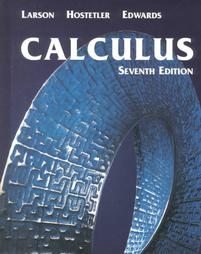Search -
Calculus With Analytic Geometry
Calculus With Analytic Geometry
Author:
Designed for the three-semester course for math and science majors, the Larson/Hostetler/Edwards series continues its tradition of success by being the first to offer both an Early Transcendental version as well as a new Calculus with Precalculus text. This was also the first calculus text to use computer-generated graphics (Third Edition... more »
Author:
Designed for the three-semester course for math and science majors, the Larson/Hostetler/Edwards series continues its tradition of success by being the first to offer both an Early Transcendental version as well as a new Calculus with Precalculus text. This was also the first calculus text to use computer-generated graphics (Third Edition... more »
ISBN-13: 9780618141807
ISBN-10: 0618141804
Publication Date: 7/2001
Pages: 182
Rating: 1
ISBN-10: 0618141804
Publication Date: 7/2001
Pages: 182
Rating: 1
3.5 stars, based on 1 rating
Publisher: Houghton Mifflin Company
Book Type: Hardcover
Other Versions: Paperback
Members Wishing: 0
Reviews: Amazon | Write a Review
Book Type: Hardcover
Other Versions: Paperback
Members Wishing: 0
Reviews: Amazon | Write a Review
Genres:
- Science & Math >> Mathematics >> Pure Mathematics >> Calculus
- Science & Math >> Mathematics >> Geometry & Topology >> Analytic Geometry
- Engineering & Transportation >> Professional Science >> Mathematics >> Geometry & Topology >> Analytic Geometry
- Engineering & Transportation >> Professional Science >> Mathematics >> Pure Mathematics >> Calculus




